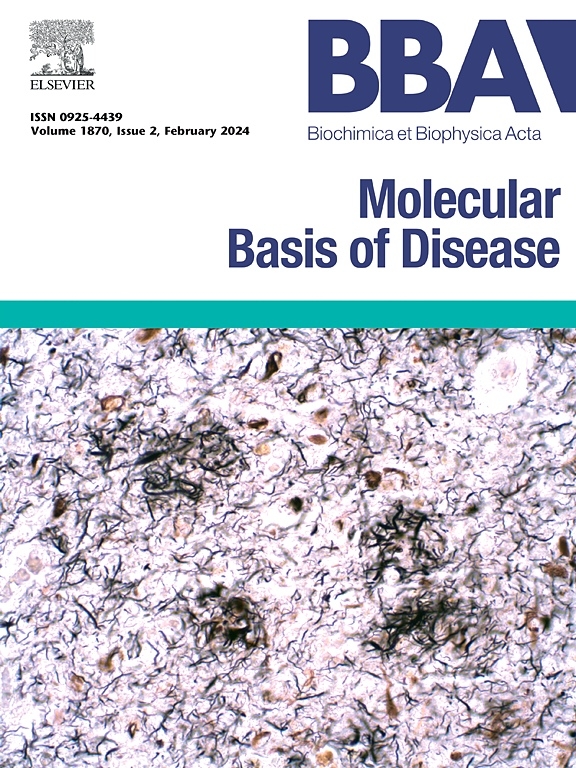C-Kit+ Mertk缺乏肝内皮细胞对非酒精性脂肪性肝炎的改善作用
IF 4.2
2区 生物学
Q2 BIOCHEMISTRY & MOLECULAR BIOLOGY
Biochimica et biophysica acta. Molecular basis of disease
Pub Date : 2025-06-27
DOI:10.1016/j.bbadis.2025.167964
引用次数: 0
摘要
最近,Mer酪氨酸激酶(Mertk)和KIT原癌基因(C-Kit)被报道在非酒精性脂肪性肝炎(NASH)患者的肝血管内皮细胞(LSECs)中发挥作用。探讨了Mertk在NASH中与C-Kit+-LSECs相关的确切机制。在这项研究中,证实了脂肪变性LSECs以及NASH患者和小鼠肝脏中C-Kit水平较低和Mertk/p-Mertk水平较高。C-Kit被认为在脂肪变性LSECs中负向调节Mertk信号。敲除Mertk的脂肪变性LSECs显示高开窗性和柱前化CD31/玻璃体连接蛋白的表达降低;表现出抗血管生成特征,促血管生成VEGF表达降低;并表现出抑制增殖、迁移和血管舒张的作用。骨髓移植(BMT) C-Kit+- ecsh -Mertk(内皮细胞缺乏Mertk)对NASH小鼠具有同等的内皮功能保护作用。与LSECssh-Mertk共培养的脂肪变性肝细胞或肝星状细胞显示脂质沉积减少;降低促脂LXR/SREBP-1c、促炎TNF-α/IL-6、促纤维化α-SMA/ColI/ tgf - β1表达;增生性FXR/ADPN表达增加;促进细胞增殖和细胞凋亡。同样,对NASH小鼠进行C-Kit+- ecsh - mertk的BMT可以改善疾病预后。经Mertk切割的C-Kit+-LSECs可限制NASH进展。因此,Mertk缺乏应该成为NASH患者恢复LSECs的一种新的治疗药物。本文章由计算机程序翻译,如有差异,请以英文原文为准。
The ameliorative effect of C-Kit+ hepatic endothelial cells with Mertk deficiency on nonalcoholic steatohepatitis
Recently, Mer tyrosine kinase (Mertk) and KIT proto-oncogene (C-Kit) were reported play a role in liver sinusoidal endothelial cells (LSECs) in patients with nonalcoholic steatohepatitis (NASH). The exact mechanism of Mertk was explored involving C-Kit+-LSECs in NASH. In this study, lower levels of C-Kit and higher levels of Mertk/p-Mertk were confirmed in steatotic LSECs and in the livers of patients and mice with NASH. C-Kit was suggested to negatively regulate Mertk signaling in steatotic LSECs. The steatotic LSECs in which Mertk was knocked down displayed high fenestration and reduced expression of procapillarized CD31/vitronectin; showed antiangiogenic features and decreased expression of proangiogenic VEGF; and exhibited inhibiting proliferation, migration and vasodilation. Bone marrow transplantation (BMT) of C-Kit+-ECssh-Mertk (endothelial cells with Mertk deficiency) to NASH mice could equivalently protect endothelial functions. Steatotic hepatocytes or hepatic stellate cells cocultured with LSECssh-Mertk exhibited diminished lipid deposition; decreased expression of prolipogenic LXR/SREBP-1c, proinflammatory TNF-α/IL-6, and profibrotic α-SMA/ColI/TGFβ1; increased expression of prolipolytic FXR/ADPN; and facilitated proliferation and apoptosis. Similarly, BMT of C-Kit+-ECssh-Mertk to NASH mice could ameliorate the disease outcome. C-Kit+-LSECs that underwent Mertk cleavage were found to limit NASH progression. Therefore, Mertk deficiency should be a novel therapeutic agent for restoring LSECs in patients with NASH.
求助全文
通过发布文献求助,成功后即可免费获取论文全文。
去求助
来源期刊
CiteScore
12.30
自引率
0.00%
发文量
218
审稿时长
32 days
期刊介绍:
BBA Molecular Basis of Disease addresses the biochemistry and molecular genetics of disease processes and models of human disease. This journal covers aspects of aging, cancer, metabolic-, neurological-, and immunological-based disease. Manuscripts focused on using animal models to elucidate biochemical and mechanistic insight in each of these conditions, are particularly encouraged. Manuscripts should emphasize the underlying mechanisms of disease pathways and provide novel contributions to the understanding and/or treatment of these disorders. Highly descriptive and method development submissions may be declined without full review. The submission of uninvited reviews to BBA - Molecular Basis of Disease is strongly discouraged, and any such uninvited review should be accompanied by a coverletter outlining the compelling reasons why the review should be considered.

 求助内容:
求助内容: 应助结果提醒方式:
应助结果提醒方式:


